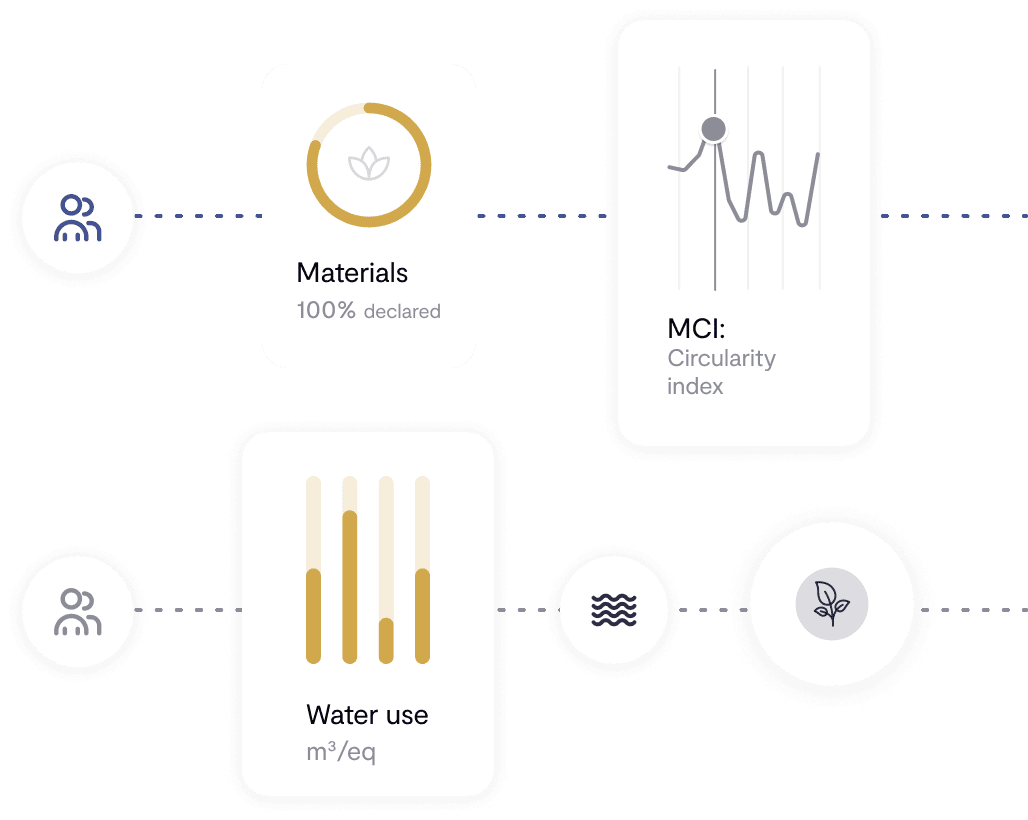The Business of Fashion and McKinsey & Company once again give us the keys to what is to come in the fashion industry. This is reflected in “The State of Fashion: Technology”, a special edition that is part of a series published to complement its annual report on the state of fashion. While the main report focuses on the changes that will shape the global apparel industry over the next 12 months, this edition seeks to analyze existing and emerging technologies to address the industry’s biggest challenges. Read on to find out what technology opportunities your business can explore to improve its competitive advantage.
This analysis aims to define how technology can help solve the challenges facing the fashion industry and generate a positive impact on business performance
Based on interviews with executives and other experts in the clothing industry, in addition to analyzes made by textile companies and market research, this report gathers the technological opportunities in which fashion professionals should focus their investment. The State of Fashion Technology Report lays the groundwork to end uncertainty and shed light on some of the hottest concepts. This analysis aims to define how technology can help solve the challenges facing the fashion industry and generate a positive impact on business performance.
According to the report, fashion companies are expected to double their technology investment by 2030. The aim will be to keep up with consumer trends and strengthen their competitive advantage. Brands will go from investing 1.6-1.8% of their income to 3-3.5%. At the same time, investors are expected to allocate their capital to companies whose technologies are focused on creating fashion in a more nimble way without neglecting environmental and social responsibility.
The pandemic has consolidated the role that technology plays in the fashion industry, accelerating the growth of e-commerce and incorporating digital tools in decision-making. Despite the fact that until now technological innovations were more oriented towards the end customer, brands in the textile sector now have the opportunity to apply these advances to strengthen their supply chain, avoid obstacles, as well as enhance their transparency.
We reveal the five technological imperatives in which professionals in the fashion industry should invest to solve some of the most urgent challenges in the sector, according to the report by BoF and McKinsey & Co.
1. Traceability first
Traceability powered by tracking software and Big Data has great potential to help fashion brands looking to achieve sustainability. Having a greater knowledge of supply chains to understand the impact of the complete life cycle of textile products is the key to making decisions aimed at improving business efficiency as well as its responsibility. Solutions such as digital passports gain relevance as verified information related to the entire life cycle of items is claimed.
The Business of Fashion and McKinsey & Co say that defining a centralized system for sustainability metrics calculations and data collection through supply chain traceability are essential to making significant progress on social and environmental goals. To achieve this, fashion brands must take into account the following:
- Lay the foundations. Brands will need to engage directly with suppliers and work with industry bodies to develop standards by which to measure company sustainability performance, backed by clear data.
- Prioritize impact areas. It’s essential to define robust metrics in order to assess which areas of the supply chain have the greatest environmental and social impact. This information will make it possible to identify where it is convenient to invest in order to reduce these impacts.
- Scale solutions. Through software and Big Data it’s possible to automate the collection of this data, regardless of the size or complexity of the supply chain. There is no excuse to know the traceability of your business.
“I think a lot of the challenges in fashion with regards to sustainability is fundamentally a data and collaboration problem. As fashion brands get more data-savvy in terms of their own supply chain, we can all jointly produce a fashion ecosystem which makes more sense and is less resource consuming”. Robert Gentz, Zalando Co-Founder & Co-Chief Executive.
2. End-to-end upgrade
Digital tools have revolutionized a large part of the fashion value chain, but these innovations are often limited to specific areas of the company, preventing improvements across the board.
According to the report, by adopting comprehensive digital solutions throughout the entire value chain, brands could see their speed to market increase by up to 50%, full-price sales by up to 8%, and lower manufacturing costs up to 20%. For this, it is recommended to follow the following guidelines:
- Balance instinct with data. It will be essential to establish a balance between decision-making based on experience and decision-making defined by data. Data-driven insights can help solve some of the fundamental challenges of the value chain.
- Prioritize journeys. In order to optimize brand performance, it’s important to focus on one or two paths along the value chain that are most critical to brand strategy, taking into account product performance, supply chain, inventory management and forecasting of purchases and demand.
- Targeted investment. Identify key enablers and fund projects that focus on machine learning and AI, cloud computing, digitized workflows, and a data network to unlock end-to-end integration.
“At Levi’s, company-wide machine learning combined with a cloud-based data repository provide multiple processes with resources to make better decisions around everything from pricing to consumer marketing”. Katia Walsh, Levi’s Chief Strategy and AI Officer.
3. Connected stores
What is the role of physical stores after the growth of e-commerce during the pandemic? 60% of European buyers still want to go to physical stores to touch and try the products before buying them.
Inside the store, those who interact with the available technology spend up to four times more time than those who don’t. Mobile apps provide a frictionless shopping experience for both those looking for functionality and a more engaging checkout flow.
To guarantee the success of technological investment in physical stores, it’s essential to take into account the following:
- Assess customer needs. It consists of defining the different types of customers that the brand assists and offering an in-store mobile application or an on-site digital experience, such as smart labels, that optimize the journey of each buyer.
- Identify basic problems. It’s necessary to understand the pain points of the service in store to implement a technology aimed at improving interactions with customers. Crossing the e-commerce data with the data collected in the store can ease a uniform and personalized service in all channels.
- Merge online with offline. The level of investment in technologies can be determined after evaluating the volume of e-commerce orders that use different purchase flows, as is the case of those purchases that are made online but are collected in the store.
“Through an in-store app, the sales associate is really able to tell the story of this product and the consumers want to buy it even if they haven’t tried it on”. Sandrine Deveaux, Farfetch Executive Vice President of Future Retail.
4. Hyper personalization
Brands increasingly have access to personalization tools that allow them to improve the way they engage with their customers. The main opportunity focuses on the exploration of Big Data and AI to create one-to-one experiences that engage their community and generate long-term loyalty.
71% of consumers expect companies to offer personalized interactions and a similar proportion say they feel frustrated when this doesn’t happen. Thanks to technological innovations, brands have the opportunity to go beyond basic segmentation and create hyper-personalized shopping experiences at all touchpoints with the consumer. These are the recommendations to achieve it:
- Investment in first-party data collection. It will be essential to adopt mechanisms for capturing own data and increasing the value of the brand through third-party data obtained thanks to external associations.
- Connection of customer data with a unique ID. To have a comprehensive view of the customer, data must be connected across channels and platforms to obtain a 360º understanding of each consumer.
- Development of AI models. Crossing data between channels will be important to create a complete view of customer profiles and align technology with brand vision.
- Deliver solutions at scale. Hyper personalization shouldn’t be limited to a specific group. Implementing design tools across content platforms to deliver multiple landing pages across all channels, prioritizing the most relevant touchpoints based on product and segment, will be essential.
- Establish customization as a backbone. In order for everything to respond to a common goal, it will be necessary to align the entire team based on a central strategy to set up a transversal personalization roadmap.
“Using technology and data to bring the right customer to the merchandise, or the right merchandise to the customer, is important because, for these million choices, how do you make sure that she finds one item? So we’re trying to use technology to personalize it for customers as much as we can”. Robert Gentz, Zalando Co-Founder & Co-Chief Executive.
5. Metaverso reality check
For a few months now, many fashion brands have taken their first steps in the metaverse through digital assets. As NFTs gain popularity in the industry, brands need to consider their strategy in the world of digital fashion in order to generate a stable revenue stream in this new environment.
Companies with a commercial presence in the metaverse are expected to generate more than 5% of revenue from virtual activities over the next five years. For this, it will be essential that those companies that are considering being part of this new world take into account the following factors:
- Determine a position. Decide if the company will create its own innovations or if, on the contrary, it will maintain a more cautious position. This should be determined based on the target and the weight of the digital environment in the general strategy of the brand.
- Analyze how to participate. What will be the value proposition of the business in the metaverse? It is essential to decide through which products and strategies the company will participate in the digital universe.
- Work long term. Depending on the goals set and their time vision, brands will have to choose to develop technological solutions internally, acquire existing products or associate with relevant players and platforms.
“Forerunner is walking before we run and thinking about where the consumer utility is and the biggest opportunities for mass consumer adoption in those spaces.” Nicole Johnson, Forerunner partner.
The main conclusion we draw from this special edition of The State of Fashion report is that technology will be critical to establishing a competitive business model in the fashion industry for years to come. Due to the complex and fragmented nature of the sector, technological innovations are key to implementing solutions that speed up the activity of brands and promote their sustainable development. Fashion businesses must embrace a new collaborative mindset to enable information sharing, while expanding tools and supporting their suppliers so they too can build a more efficient and responsible industry.
BCOME takes a multidisciplinary approach to sustainability to integrate knowledge and technology with the aim of accelerating the transition to systemic change in the fashion industry. We have the tools that your business needs to bring transparency to your supply chain and take it to the end customer. Are you joining this great change? Let’s talk!






